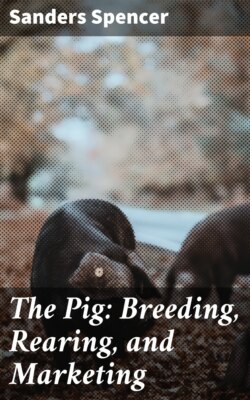Читать книгу The Pig: Breeding, Rearing, and Marketing - Spencer Sanders - Страница 6
На сайте Литреса книга снята с продажи.
The Hampshire
ОглавлениеJust why our American cousins should have decided to call these sheeted pigs Hampshires is not on the surface, since the oldest writers on pigs give to the county of Sussex the credit of being their original home. The description given by Sidney of the Hampshire pig is that "it is a coarse and useful black pig, inferior to the Berkshire, and not in the same refined class as the Essex." Richardson writes "The Hampshire breed is not infrequently confounded with the Berkshire; but its body is longer and its sides flatter; the head is long and the snout sharp. The colour of the breed is usually dark spotted; but it is sometimes black altogether, and more frequently white."
The sheeted pig has also been bred in the county of Essex for over a century, but it is recorded that it was introduced into this county by a Mr. Western who subsequently became Lord Western, and whose estate was situated in Essex.
In Sidney's book The Pig, we read, "West Sussex, Hampshire, Berkshire, Dorset, Shropshire and Wales had indigenous black or red and black breeds of swine; and between the whites, the blacks and the reds the parti-colours were produced which have since in a great degree disappeared under the influence of prizes, generally awarded to pure breeds of single colours."
Sidney also states "that Youatt and all the authors who have followed him down to the latest work published on the subject, occupy space in describing various county pigs which have long ceased to possess, if they ever possessed, any merit worth the attention of the breeder."
The Rudgwick, which is another name for the sheeted pig, is included in the list. Richardson at a still earlier date describes the Sussex breed as "black and white in colour, but not spotted; that is to say, these colours are distributed in very large patches; one half—say, for instance, the fore part of the body white and the hinder end black; or sometimes both ends black and the middle white or vice versâ; these pigs are in no way remarkable; they seldom feed to over twenty stone. They are well made, of middle size, and their skin covered with scanty bristles. The snout tapering and firm, the ears upright and pointed, the jowl deep and the body compactly round. They arrive at early maturity, fatten quickly, and the flesh is excellent."
Richardson also writes, "There is another improved Essex breed, called the Essex Half-Blacks, resembling that which I have described in colour, said to be descended from the Berkshire. This breed was originally introduced by Lord Western, and obtained much celebrity," etc. etc.
He then quotes from The Complete Grazier, sixth edition, as follows: "They are black and white, short haired, fine skinned with smaller heads and ears than the Berkshire, but feathered with inside hair which is a distinctive mark of both; have short snubby noses, very fine bone, broad and deep in the belly, full in the hind quarters, but light in the bone and offal. They feed remarkably fast and are of an excellent quality of meat. The sows are good breeders, and bring litters of from eight to twelve; but they have the character of being bad nurses." If this allegation were true at the time it was written, it is not at the present time as the Half-Blacks or sheeted sows are both prolific and first-rate mothers.
Malden describes the Sussex: "A large breed called the Rudgwick, was one of the largest in England. There appears to be a doubt as to whether the coloured pig was descended from the spotted Berkshire or the black and white Essex. They were of medium size, of good quality generally, but of somewhat heavy bone." The generally accepted view is that the Essex sheeted pig was descended from importations from the county of Sussex. These sheeted pigs are still occasionally met with in Essex, but the system of crossing which is generally followed by pig breeders in the county is gradually reducing its number, although even amongst the cross-breeds the peculiar marking occasionally shows itself. At the time of writing there is a movement on foot to form a society for the purpose of reviving the breed. From the utility point of view the sheeted pig has much to recommend it, but whether or not one or more of the breeds of pigs whose pedigrees are already recorded do not possess at least equal merits must be left for decision by others.
